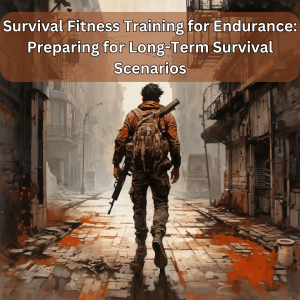In an increasingly uncertain world, urban gardening has emerged as a vital pursuit for preppers and survivalists seeking to ensure food security and self-sufficiency. By cultivating your own food in urban environments, you can prepare for emergencies, build resilience, and reduce dependence on external food sources. This comprehensive guide is designed to empower preppers and survivalists with practical tips and detailed information on successful urban gardening techniques, along with long-term food storage methods such as canning, freeze drying, and dehydrating.
Section 1: Getting Started with Urban Gardening for Preppers and Survivalists

- Assessing Available Space for Maximum Efficiency
To make the most of your urban space, carefully evaluate the areas you have available, such as balconies, rooftops, windowsills, or indoor spaces. Consider factors like sunlight exposure, access to water, and local climate conditions. Optimize your growing area by utilizing vertical gardening techniques, such as trellises or wall-mounted planters, to maximize space. Choose compact plant varieties suitable for container gardening, focusing on highly nutritious and calorie-dense crops like root vegetables (potatoes, carrots), legumes (beans, peas), leafy greens (kale, spinach), and high-yield crops (zucchini, tomatoes).
- Building Resilient Garden Infrastructure
Ensure your garden infrastructure is resilient and capable of withstanding challenging conditions. Prepare sturdy containers or raised beds that can handle urban environments. Implement water catchment systems, such as rain barrels or drip irrigation, to ensure a reliable water supply during emergencies. Consider alternative energy sources, such as solar power, to sustain essential gardening equipment.
- Utilizing Permaculture and Companion Planting Principles
Apply permaculture principles to create a sustainable and self-sustaining garden ecosystem. Incorporate companion planting techniques to enhance pest management, soil fertility, and maximize space utilization. For example, planting marigolds alongside vegetables can deter pests, while growing nitrogen-fixing plants like legumes improves soil health. Embrace the concept of “food forests” by planting a variety of trees, shrubs, and edible plants that complement and support each other.
- Soil Preparation and Nutrient Management
Prioritize soil health by preparing a nutrient-rich growing medium. Create a well-draining soil mix using a combination of compost, peat moss, and vermiculite. Regularly amend the soil with organic matter like compost, worm castings, or aged manure to improve fertility and structure. Conduct soil tests to monitor nutrient levels and adjust fertilization accordingly.
Section 2: Long-Term Food Storage Techniques for Preppers and Survivalists

- Canning: Preserving Harvests for Extended Periods
Canning is a time-tested method for preserving food, allowing you to enjoy your homegrown produce throughout the year. Learn both hot water bath canning for high-acid foods (fruits, tomatoes, pickles) and pressure canning for low-acid foods (vegetables, meats, soups). Gather canning supplies, including jars, lids, rings, a boiling water canner or pressure canner, a jar lifter, and a canning funnel. Follow proper safety measures and guidelines to prevent the growth of harmful bacteria. Fill jars with prepared food, remove air bubbles, and process them according to the recommended time and pressure. Store the jars in a cool, dark place and check for proper seals before consumption.
- Freeze Drying: Optimal Preservation of Nutrients and Flavor
Freeze drying is a technique that removes moisture from food, resulting in excellent preservation of nutritional content, flavor, and texture. Invest in a freeze dryer to process fruits, vegetables, and even cooked meals. Select fresh produce at its peak ripeness, wash, and cut it into small pieces for quicker drying. Arrange the food on freeze-drying trays and follow the manufacturer’s instructions for drying times and temperatures. Once dried, pack the food in airtight containers or Mylar bags with oxygen absorbers to extend its shelf life.
- Dehydrating: Efficient Preservation of Food
Dehydrating is a simple and effective method of preserving food by removing moisture. Use a food dehydrator or oven set at low temperatures to dehydrate fruits, vegetables, and herbs. Slice the produce into uniform pieces and arrange them on drying racks. Monitor the drying process to ensure proper dehydration without overheating. Once dehydrated, store the food in airtight containers or vacuum-sealed bags in a cool, dark place.
Section 3: Additional Tips for Preppers and Survivalists Engaged in Urban Gardening

- Seed Saving and Propagation
Develop seed-saving skills to ensure a renewable seed source for future planting. Learn how to collect, clean, and store seeds from your open-pollinated plants. Experiment with seed propagation techniques such as cloning, taking cuttings, or starting seeds indoors to expand your plant collection.
- Composting and Soil Health
Establish a composting system to recycle kitchen scraps and garden waste into nutrient-rich compost. Compost acts as a natural fertilizer, improving soil fertility, structure, and moisture retention. Apply compost regularly to enrich the soil and promote healthy plant growth.
- Pest and Disease Management
Implement organic pest control methods to protect your crops from harmful insects and diseases. Employ preventive measures such as companion planting, proper spacing, and regular inspection to minimize pest infestations. Use organic solutions like neem oil, insecticidal soap, or diatomaceous earth to control pests while avoiding chemical contamination.
Conclusion
Urban gardening holds tremendous potential for preppers and survivalists, offering a pathway to food security, self-sufficiency, and resilience in times of uncertainty. By following the comprehensive guidelines provided in this article, you can embark on a successful urban gardening journey, cultivating nutritious crops in limited spaces. Additionally, mastering long-term food storage techniques such as canning, freeze drying, and dehydrating ensures that your harvests will sustain you during emergencies and beyond. Embrace urban gardening as a cornerstone of your preparedness strategy and gain the skills and knowledge necessary to thrive in any situation.





